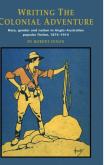 325008893917587942.jpg
325008893917587942.jpg
 Writing the Colonial Adventure : Race, Gender and Nation in Anglo-Australian Popular Fiction, 1875-1914
single work
Writing the Colonial Adventure : Race, Gender and Nation in Anglo-Australian Popular Fiction, 1875-1914
single work
 325008893917587942.jpg
325008893917587942.jpg
 Writing the Colonial Adventure : Race, Gender and Nation in Anglo-Australian Popular Fiction, 1875-1914
single work
Writing the Colonial Adventure : Race, Gender and Nation in Anglo-Australian Popular Fiction, 1875-1914
single work
'This book is an exploration of popular late nineteenth-century texts that show Australia - along with Africa, India and the Pacific Islands - to be a preferred site of imperial adventure. Focusing on the period from the advent of the new imperialism in the 1870s to the outbreak of World War I, Robert Dixon looks at a selection of British and Australian writers. Their books, he argues, offer insights into the construction of empire, masculinity, race, and Australian nationhood and identity. Writing the Colonial Adventure shows that the genre of adventure/romance was highly popular throughout this period. The book examines the variety of themes within their narrative form that captured many aspects of imperial ideology. In considering the broader ramifications of these works, Professor Dixon develops an original approach to popular fiction, both for its own sake and as a mode of cultural history.' (Introduction)
'This reading of transvestic performance in Australian fiction is in dialogue with Robert Dixon’s 1995 monograph Writing the Colonial Adventure: Race, Gender and Nation in Anglo-Australian Popular Fiction, 1875-1914. It is informed by the frameworks Dixon developed in his analysis of the relationship between literature and culture, specifically the ways in which he relates the occult effects of the literary imaginary and the political unconscious to historical context and their implication in the formation of Australia’s particular colonialism. More specifically still, the argument regarding colonial transvestism engages directly with Dixon’s deployment of Peter Stallybrass and Allon White’s formulation of the ‘grotesque’ and its application to the Australian colonial context. The essay revisits Dixon’s reading of the Australian grotesque as a critical optic for reading Australian colonial narratives of female to male cross-dressing to argue that the transvestite figures in colonial narratives enact performances of what Stallybrass and White schematise as the two orders of the grotesque, which are enacted in the identity formation of the collective.' (Publication abstract)
The British romantic novel became a distinct and bestselling genre during the mid-nineteenth century, when Charlotte M. Yonge’s The Heir of Redclyffe (1853) inspired other authors to write thrilling love stories published in triple-decker volumes that were sold at W.H. Smith railway bookstalls or circulated through 'Charles Mudie’s Select Library (Anderson 1974, p. 25). Women writers during this time, such as Yonge, Rhoda Broughton and Mary Elizabeth Braddon, popularised stories that featured the trials and tribulations of British heroes and heroines who fall in love, overcome various obstacles to their relationship, marry or are tragically parted by death (Anderson 1974). Most of their novels are set in Britain or, for more exotic fare, the Continent. However, from the 1890s onwards, they were joined by women writers from Britain’s colonies and dominions. This period was the zenith of British imperial power and, unsurprisingly, women writers used the colonies as exotic backdrops for their love stories. Romantic novels from the 1890s to the Second World War spread imperial fantasies of women who travelled to the colonies, hunted, worked as governesses, nurses and secretaries, managed households, ran viable plantations, fended off attacks by ‘the natives’, fell in love, married and made a place for themselves in the empire. Dreams of love and empire building bloomed in what I am calling women’s imperial romantic novels: love stories set in India, the white settler colonies and dominions, and Saharan and sub-Saharan Africa in the late nineteenth and early twentieth centuries.' (Publication summary)
'No longer nostalgically regarded as repositories of a lost innocence, tales of boys playing violent games at the frontiers of Empire have been shown to betray fears of the Other in both domestic and foreign forms.' (Introduction)